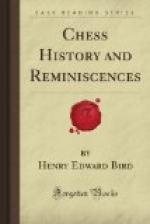The accounts of the Hindu Chaturanga (which means game of “four angas,” four armies, or “four species of forces,” in the native language, Hasty-aswa-ratha-padatum, signifying elephants, horses, chariots and foot soldiers) (According to the Amara Kosha, and other native works as explained by Dr. Hyde and Sir William Jones) give a description of the game sufficiently clear to enable anyone to play it in the present day.
Note. We have tried it recently. So great of course is the element of luck in the throw, that the percentage of skill though it might tell in the long run is small, perhaps equal to that at Whist.
------
With every allowance for more moderate estimates of antiquity by some Sanskrit scholars, the Chaturanga comes before any of the games mentioned in other countries sometimes called chess, but which seem to bear no affinity to it. The oldest of these games is one of China, 2300 B.C., attributed to Emperor Yao or his time, another in Egypt of Queen Hatasu daughter of Thotmes I, 1771 to 1778 B.C., and that inscribed on Medinet Abu at Egyptian Thebes, the palace constructed by Rameses iv (Rhameses Meiammun, supposed grandfather of Sesostris) who according to the scrolls, we are told reigned 1559 to 1493 B.C., and is said to be the monarch represented on its walls. According to the Bible Chronology he would be contemporary with Moses who lived 1611 to 1491 B.C.
The moves of all the pieces employed in the Chaturanga were the same as those made in Asia and Europe down to the close of the Fifteenth century of our era. The Queen up to that time was a piece with only a single square move, the Bishop in the original game was represented by a ship, the Castle or Rook (as it is now indiscriminately called) by an elephant, the Knight by a horse, the two last named have never at any time undergone the slightest change, the alteration in the Bishop consists only in the extension of its power of two clear moves, to the entire command of its own coloured diagonal. The total force on each side taking a Pawn as 1 for the unit was about 26 in the Chaturanga as compared with 32 in our game. There appear ample grounds for believing that the dice used, constituted the greatest if not the main charm in the game with the Brahmans, and that the elimination of that element of chance and excitement, destroyed its popularity with them.
------
THE ANCIENT HINDU CHATURANGA
The Chaturanga signifies the game of four angas, or four species of forces, which, according to the Amira Kosha of Amara Sinha and other authorities means elephants, horses, chariots and foot soldiers, which, in the native tongue is Hasty, aswa, ratha, padatum. It was first brought to notice by the learned Dr. Thomas Hyde of Oxford, in his work De Ludus Orientalibus, 1694. About 90 years later the classical Sir William Jones, also of Oxford, who became Judge of




